Ettore Sottsass Jr. Follow 'Nefertiti' writing desk 1968-1969 Plastic-laminated wood, steel. 110.2 x 126.9 x 35.2 cm (43 3/8 x 49 7/8 x 13 7/8 in.) Manufactured by Poltronova, Agliana, Italy.
Provenance Private collection, Turin Literature Ettore Sottsass 'Sottsass a Stoccolma', Domus , no. 474, May 1969, p. 54 Poltronova, Sottsass , Agliana, 1970, n.p. Emilio Ambasz Italy: The New Domestic Landscape: Achievements and Problems of Italian Design , exh. cat., Museum of Modern Art, New York, 1972, p. 50 Giuliana Gramigna Repertorio 1950/1980 , Milan, 1985, p. 294 Barabara Radice, Ettore Sottsass A Critical Biography , London, 1993, p. 116 Hans Höger, Ettore Sottsass Jun. Designer, Artist, Architect , Tübingen, 1993, p. 87 Par Milco Carboni, Ettore Sottsass Jr. ’60-’70 , exh. cat., FRAC Centre, Orléans, 2006, pp. 114-15 for images and drawings Video The Enduring Legacy of Ettore Sottsass Three Experts on the Designer's Impact Together in Paris, three experts, author Fulvio Ferrari curator Marina Vignozzi and our own European Head of Design, Domenico Raimondo take a closer look at the legacy of Ettore Sottsass alongside three landmark works: His 'Nefertiti' writing desk from 1968-69, the painted oak 'Unique totem, no. 18' from 1966, and his 'Composition of coloured wooden elements and mirror; all joined by hemp ropes’ from 1959. Catalogue Essay The ‘Nefertiti’ writing desk is amongst the first furniture pieces to be executed with decorative plastic laminate in the history of design. It is the result of the collaboration between Ettore Sottsass and the Italian manufacturer Abet Laminati, the first to introduce new techniques for screen-printing of plastic laminates following Sottsass’ vision. Designed in 1967, stylistically, the design follows from the series of ‘Superbox’ wardrobes, which Sottsass also conceived for Poltronova. Importantly, with these designs, Sottsass sought to demonstrate to Abet Laminati the economic potential of this innovative process. The large series of enigmatic column-shaped units which, freed from clear function and endowed with a strong figurative value, impose a new way of domestic living and interacting. Large remaining a conceptual project for Sottsass, and with only a few prototypes ever produced, the project initiated a laminate screen-printing workshop at Abet Laminati. Equally colourful and enigmatic, the ‘Nefertiti’ writing desk was introduced to the Poltronova catalogue shortly thereafter, where it was offered until the mid-1970s. Exclusively by order, only a few examples of the desk were ever executed. The original design was conceived by Sottsass in white and green vertical laminate stripes on the exterior, with a white interior, such as the present lot. Colour variations included pink and white stripes, with white interior; green and white stripes applied only on the front and back elevation, with all other sides in white; or entirely white monochrome. It is probable that other variations also exist. The green and white striped writing desk was included in the principal exhibitions on Ettore Sottsass’ work of this period, notably the ‘Miljo for en ny Planet’ exhibition at the National Museum of Stockholm in 1969, and ‘Italy: The New Domestic Landscape’ at MoMA, New York in 1972, the latter acquiring the writing desk for their permanent collection the same year. Architetto Milco Carboni Read More
Ettore Sottsass Jr. Follow 'Nefertiti' writing desk 1968-1969 Plastic-laminated wood, steel. 110.2 x 126.9 x 35.2 cm (43 3/8 x 49 7/8 x 13 7/8 in.) Manufactured by Poltronova, Agliana, Italy.
Provenance Private collection, Turin Literature Ettore Sottsass 'Sottsass a Stoccolma', Domus , no. 474, May 1969, p. 54 Poltronova, Sottsass , Agliana, 1970, n.p. Emilio Ambasz Italy: The New Domestic Landscape: Achievements and Problems of Italian Design , exh. cat., Museum of Modern Art, New York, 1972, p. 50 Giuliana Gramigna Repertorio 1950/1980 , Milan, 1985, p. 294 Barabara Radice, Ettore Sottsass A Critical Biography , London, 1993, p. 116 Hans Höger, Ettore Sottsass Jun. Designer, Artist, Architect , Tübingen, 1993, p. 87 Par Milco Carboni, Ettore Sottsass Jr. ’60-’70 , exh. cat., FRAC Centre, Orléans, 2006, pp. 114-15 for images and drawings Video The Enduring Legacy of Ettore Sottsass Three Experts on the Designer's Impact Together in Paris, three experts, author Fulvio Ferrari curator Marina Vignozzi and our own European Head of Design, Domenico Raimondo take a closer look at the legacy of Ettore Sottsass alongside three landmark works: His 'Nefertiti' writing desk from 1968-69, the painted oak 'Unique totem, no. 18' from 1966, and his 'Composition of coloured wooden elements and mirror; all joined by hemp ropes’ from 1959. Catalogue Essay The ‘Nefertiti’ writing desk is amongst the first furniture pieces to be executed with decorative plastic laminate in the history of design. It is the result of the collaboration between Ettore Sottsass and the Italian manufacturer Abet Laminati, the first to introduce new techniques for screen-printing of plastic laminates following Sottsass’ vision. Designed in 1967, stylistically, the design follows from the series of ‘Superbox’ wardrobes, which Sottsass also conceived for Poltronova. Importantly, with these designs, Sottsass sought to demonstrate to Abet Laminati the economic potential of this innovative process. The large series of enigmatic column-shaped units which, freed from clear function and endowed with a strong figurative value, impose a new way of domestic living and interacting. Large remaining a conceptual project for Sottsass, and with only a few prototypes ever produced, the project initiated a laminate screen-printing workshop at Abet Laminati. Equally colourful and enigmatic, the ‘Nefertiti’ writing desk was introduced to the Poltronova catalogue shortly thereafter, where it was offered until the mid-1970s. Exclusively by order, only a few examples of the desk were ever executed. The original design was conceived by Sottsass in white and green vertical laminate stripes on the exterior, with a white interior, such as the present lot. Colour variations included pink and white stripes, with white interior; green and white stripes applied only on the front and back elevation, with all other sides in white; or entirely white monochrome. It is probable that other variations also exist. The green and white striped writing desk was included in the principal exhibitions on Ettore Sottsass’ work of this period, notably the ‘Miljo for en ny Planet’ exhibition at the National Museum of Stockholm in 1969, and ‘Italy: The New Domestic Landscape’ at MoMA, New York in 1972, the latter acquiring the writing desk for their permanent collection the same year. Architetto Milco Carboni Read More
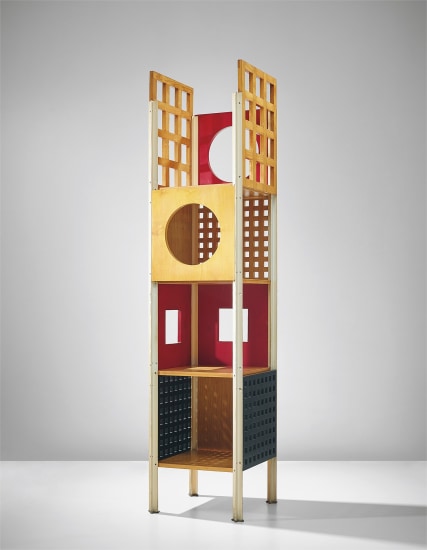

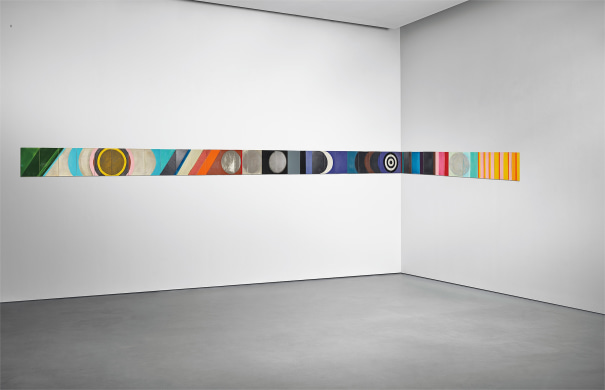




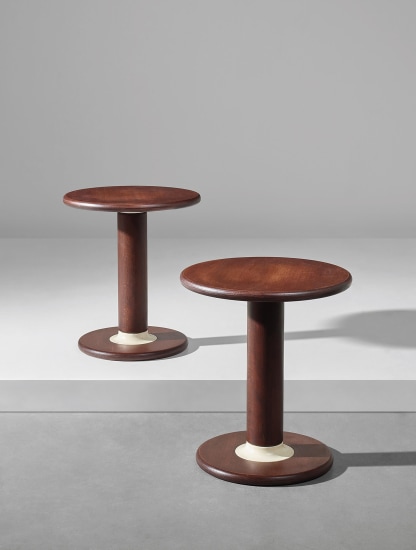
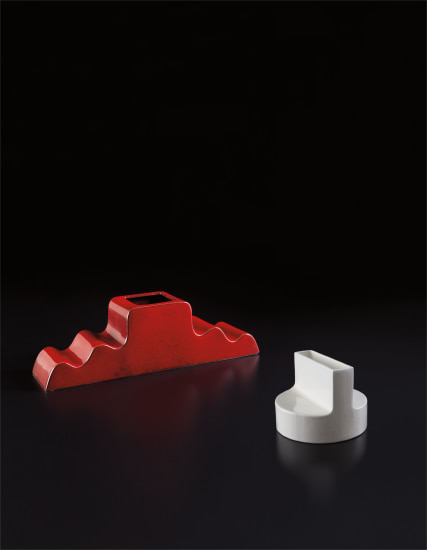
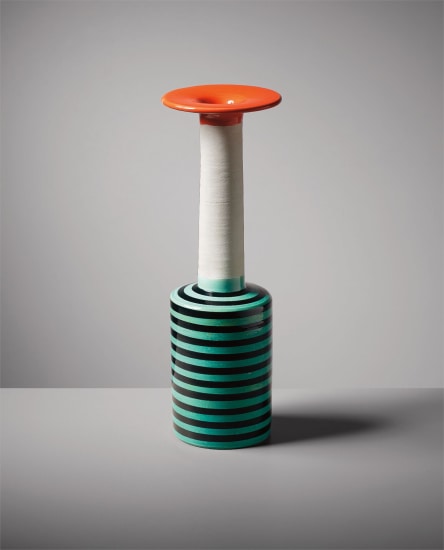
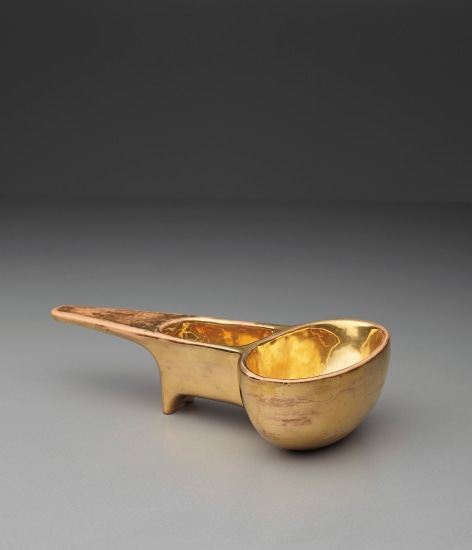
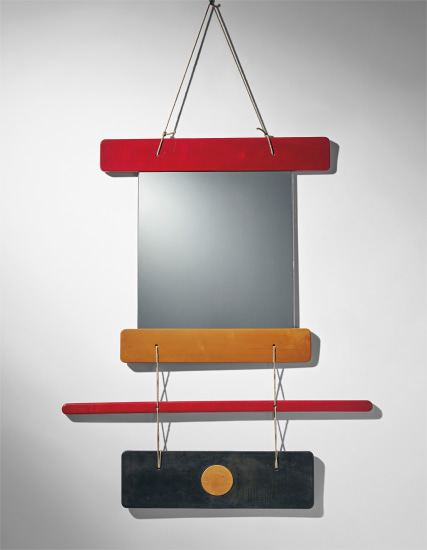

Testen Sie LotSearch und seine Premium-Features 7 Tage - ohne Kosten!
Lassen Sie sich automatisch über neue Objekte in kommenden Auktionen benachrichtigen.
Suchauftrag anlegen